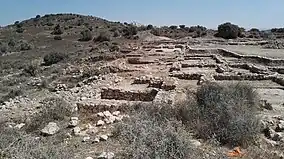Jarmuth
Jarmuth, Hebrew: Yarmut[1] (יַרְמוּת), was the name of two cities in the land of Canaan.[2]
| Jarmuth | |
|---|---|
| Khŭrbet el-Yarmûk | |
 Tel Jarmuth, near Beit Shemesh | |
| Nearest city | Beit Shemesh |
| Coordinates | 31°42′30″N 34°58′30″E |
| Established | Bronze Age |
The Douai-Rheims version of the Bible has an alternative spelling, Jaramoth.
Jarmuth near Beit Shemesh
Jarmuth was an Amorite city in Canaan at the time of the Israelite settlement recorded in the Hebrew Bible. According to Joshua 10:3–5, its king, Piram, was one of five kings who formed an alliance to attack Gibeon in response to Gibeon making a treaty with the Israelites led by Joshua, who had recently conquered the cities of Jericho and Ai. This Jarmuth is commonly identified with a modern site variously called Tel Yarmuth[3] in Hebrew, Tel Jarmuth,[2] or Khirbet el-Yarmûk[4] in Arabic (grid position 147124 PAL).[5] The site is located on the south of Beit Shemesh, near Bayt Nattif, and is now a National Park.[6] The Park spans over an area of 267 dunams (nearly 66 acres).
Jarmuth in Issachar
Another Jarmuth became a Levitical city given to the Gershonites within the territory of the Tribe of Issachar, according to Joshua 21:20. Jarmuth is not mentioned in the parallel list of Levitical cities in 1 Chronicles 6), but Ramoth is mentioned in its place (1 Chronicles 6:73). The site of the Issacharian Jarmuth is not yet known,[2] but it is identified by some with the site of Kawkab el-Hawa, which if correct might also correspond to Second Temple period Agrippina.[7]
References
- Negev & Gibson (2001), "Yarmut (b) (Tel); Yarmuk (Khirbet el-)", pp. 181, 234, 545.
- Lemche (2010), p. 160.
- de Miroschedji (1990)
- Robinson (1856), p. 17.
- Aharoni, Y. (1979). The Land of the Bible: A Historical Geography (2 ed.). Philadelphia: Westminster Press. p. 437. ISBN 0664242669. OCLC 6250553. (original Hebrew edition: 'Land of Israel in Biblical Times - Historical Geography', Bialik Institute, Jerusalem (1962))
- Tel Yarmut National Park (Hebrew)
- Negev & Gibson (2001), Yarmut (a), p. 545.
Bibliography
- de Miroschedji, Pierre. (1990). The Early Bronze Age Fortifications at Tel Yarmut – An Interim Statement. Eretz-Israel: Archaeological, Historical, and Geographical Studies. Volume 21.
- Lemche, Niels Peter (9 April 2010). The A to Z of Ancient Israel. Scarecrow Press. p. 160. ISBN 978-1-4616-7172-5.
- Negev, Avraham; Gibson, Shimon, eds. (2001). Yarmut (a); Yarmut (b) (Tel); Yarmuk (Khirbet el-). p. 545. ISBN 0-8264-1316-1. Retrieved 18 February 2022.
{{cite book}}:|work=ignored (help) (Snippet view). - Robinson, Edward (1856). Biblical Researches in Palestine. Vol. II, section XI, London, p. 17.